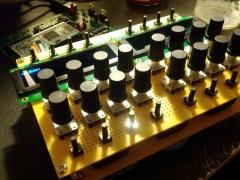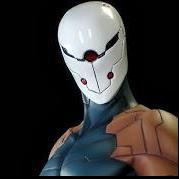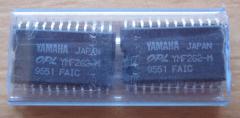-
Posts
3,633 -
Joined
-
Last visited
-
Days Won
36
Content Type
Profiles
Forums
Blogs
Gallery
Everything posted by Hawkeye
-
Looking really great! :-) Can´t wait to test out the the bassline sequencer engine mode, it looks very intuitive :), also it is nice to see much of the lead engine parameters on one screen, this should really help the patch creation process :) Greets, Peter
-

prototype for my second midibox live device
Hawkeye commented on ultra's gallery image in Members Gallery
-

MIOS32 Voxel Space Graphics Demo on 256x64 Graphical OLED
Hawkeye replied to Hawkeye's topic in MIOS toy of the week
Yo, man! Looking great already! Greets, Peter -
Great job! The MBSID Ctrlr UI looks mighty fine! Greets, Peter
-

MIOS32 Voxel Space Graphics Demo on 256x64 Graphical OLED
Hawkeye replied to Hawkeye's topic in MIOS toy of the week
yes, if tha caps don´t work, the display initialization needz moar brainz :) have a great weekend and have fun experimenting with tha font codez ;-) -

MIOS32 Voxel Space Graphics Demo on 256x64 Graphical OLED
Hawkeye replied to Hawkeye's topic in MIOS toy of the week
Very slight screen flickering might be also due to the "improvised" display initialization - i experimented for hours with different init values - all completely different than the newhaven values :) But putting a "buffering" cap to the 2.5V main display power supply is a good idea! Regarding font output - it depends on your timeframe, i might get some code running next (not this) weekend, it should not be soo hard... For my intended use, i´d like the screen to be divided into 64x16 pixel rectangle regions (each one corresponding to an encoder), each region filled with either two lines of 8 pixel high text (tiny) or one line with 16 pixel high text (well readable). Bye! Peter -
hot :) http://youtu.be/4593D44Lid4
-

MIOS32 Voxel Space Graphics Demo on 256x64 Graphical OLED
Hawkeye replied to Hawkeye's topic in MIOS toy of the week
Great work! Are there any display flickering/stability issues with this setup, now? Very cool! Bye, Peter -

MIOS32 Voxel Space Graphics Demo on 256x64 Graphical OLED
Hawkeye replied to Hawkeye's topic in MIOS toy of the week
Well done! Have to order a few 4050s @ next Reichelt order! :) Greets, Peter -
Thanks, Tim(s)! :clover: Currently no time for MIDIboxing, but will hopefully be better later :-) Many greets, Peter
-
Ein paar Anmerkungen (keine Garantie, habe erst ein Linearnetzteil gebaut, bin für Korrekturen dankbar :)) * Ein 12V Trafo müsste ausreichen, da nach dem Brückengleichrichter +/- 12V*1.4 anliegen (die Ladeelkos laden auf die Sinus-Spitzenspannung auf) = +/- 16.8 V liegen an, diese Überschussspannung reicht für die 7812/7912. * Habe in meinem MB6582 Linear-Netzteil insgesamt 2200uF * 2 = 4400uF Eingangskondensatorkapazität (C1, C2), was sich mit der Faustregel von 470 uF pro 0.1A halbwegs deckt. Die sind auch nötig, mit 2200uF bilde ich mir leichte Audio-Störungen ein - Stromaufnahme liegt bei mir über 1A auf 5V (VFD, 8x SID, 4x Core8) * C3, C4, C5, C6 kannst Du aus den Datenblättern der V-Regs entnehmen - diese Kondensatoren sehr nahe bei den Spannungswandlern anbringen, da sonst Störungen auftreten können - für meinen 7805 taten es zwei mal 0.1uF, auch wenn im Datenblatt 0.1uF /0.3uF steht. * ich würde eher C5, C6 mit 100nF = 0.1uF bestücken und C7/C8 mit 47uF. * Kühlkörper sind zwingend nötig, wenn Du z.B. auf der 5V Schiene mit annähernd 1A rechnest, sogar ein sehr sehr grosser, da die gesamte Spannungsdifferenz von 12*1.4 auf 5V verbrannt wird - Du kannst auch zweistufig vorgehen, erst einen 7809, um auf 9V runterzuwandeln und dann einen 7805, oder einen Lastwiderstand, der die Eingangsspannung des 7805 mindert (und auch heiss werden darf). Ich denke mal, Du kannst das alte Core8-Modul auch von aussen mit 5V versorgen und brauchst nicht den Spannungswandler drauf. Ich persönlich würde nicht 500mA + von 16.8V auf 5V runterbrennen, ist ineffizient, ein separater Trafo mit z.B. 7.5V, 1A wäre besser - und für die +/-12V Schiene brauchst Du ja kaum Strom und kannst einen sehr kleinen Trafo (2x 100mA) verwenden. Das kann man dann wenn man die Verkabelung sorgfältig macht auch alles in einer Box zusammenschliessen - schau Dir mal TKs FM Referenz auf ucapps.de an, er hat auch zwei Trafos drin! Ciao, Peter
-
Look at juliens picture - same 6 pins plus 2 fastener pins. As it is 270°, it is an analog pot, detention is also possible in analog pots, of course... Could be a stereo pot which splits the resistor value for each channel = 2x3 pins plus two pins for better fastening the pot to the PCB. Bye, Peter
-
Bzgl AOUT_NG (nehme an Du willst so eins bauen) - hab selber noch keins gebaut, aber die Datenblätter helfen - der DAC zieht max 20mA, die beiden Quad OpAmps ziehen bei Ausgangs-Kurzschluss maximal jeweils 60mA, ohne Last 2.5mA und im Normalbetrieb wohl auch nicht mehr als jeweils 10mA. Da kannst Du noch ein bisschen was für die passiven Komponenten draufrechnen, aber viel mehr wirds nicht. Bzgl. OLEDs - sie sehen schon sehr schön aus und ich hab eins in einen Waldorf Micro Q gesteckt, ohne Probleme. Das war ein 2x20er von Newhaven - die 4x20er von Newhaven machen jedoch Kompatibilitätsprobleme und benötigen eine Treiberanpassung, die 2x40er hat mangels Verfügbarkeit wohl noch niemand richtig getestet, aber auch hier könnte es Probleme geben - so gesehen bist Du mit einem 2x40er LCD auf der sicheren Seite. Die Optrex STEP LCDs (gibts in 2x40) schauen für LCDs sehr gut aus! http://www.optrex.com/products/groupdetail.asp?tag=40X2 Ciao! Peter
-
Hi, can you provide us with hi-res pictures of the failed component? Did the volume control act "stepped" (= probably a digital encoder) or continous (= probably an analog potentiometer)? If it says 100k, it is most likely a classic analog potentiometer (= variable resistor) and not a digital encoder - in any case you should be able to find a replacement part when browsing the larger online stores like mouser.com. Greets, Peter
-
Private Schätzungen, ohne Garantie: Core8 100mA Backlit LCD 250mA DIN ~ 50mA (Seppomans Schätzung) DOUT ca 10-20mA pro LED (bei Matrix/BLM weniger), 16 gleichzeitig leuchtende LEDs geschätzt 240mA OPL3/AOUT nicht mehr als 50mA auf +/- 12V 500mA auf 5V und 50mA auf +/- 12V könnten reichen 1A auf 5V und 100mA auf +/- 12V sollten reichen. Miss doch mal durch und gib uns Bescheid, was bei Dir letzlich rauskommt, dann haben alle was davon - ein total unterdimensioniertes Netzteil macht auch keinen Sinn... Hier noch ein Link: http://www.midibox.o...bipolar_12v_psu Schönen Abend und viel Spass beim Basteln! Peter PS: wenn Dir die 2x40 LCDs zu langweilig sind und Du kein OLED bekommst, gäbe es auch feine VFDs, die aber etwas mehr Strom brauchen (schätze 350mA) - hier in meinem Seq V4: http://midibox.org/forums/uploads/gallery_7895_68_282339.jpg Wird dann aber teuer, da ich aus Kompatibilitätsgründen nur noch Noritake empfehlen würde...
-
Hängt vom Anwendungszweck ab - z.B. für Acul, der "nur" eine normale MIDIbox mit einigen Potis betreiben will, sind die super geeignet, klein, günstig und energieeffizient. Für Audioanwendungen (FM, SID) existieren unterschiedliche Meinungen - aber Schaltnetzteile guter Qualität mit hoher Schaltfrequenz sollten in jedem Fall weit weniger Störungen verursachen als das Chiprauschen eines 6581, so dass es wohl zu vernachlässigen ist... Der Bau eines einfachen (linearen) Netzteils ist kein Hexenwerk solange man aufpasst und nicht in die 220V langt :). Es gibt auch 2-Ampere Spannungswandler, wie den 78S05, aber Du brauchst in jedem Fall einen ausreichend grossen Kühlkörper, weil die überschüssige Spannung verbrannt wird... Edit: ich finds nicht gut, wenn man über einen USB-Port mehr als 500mA saugt, egal wieviel Saft der USB-Hub hergibt... irgendwann steckt man die MIDIbox an einen anderen USB-Port und die Verwunderung, warum nichts geht, ist sehr gross :-). Ciao, Peter
-
Ich kenne die Stromaufnahme des neuen AINSER64 Moduls nicht, aber Du hast bei geschätzten 250mA Stromaufnahme durch das CORE_LPC17 nochmal ca 250 mA zur Verfügung, bis Du ans Limit der USB-Spezifikation (500mA) gelangst. Damit kommt man schon ziemlich weit! Wenn Du jedoch viele DOUTs und nicht gemulitiplexte LEDs verwendest (10-20 mA pro dauerhaft leuchtender LED), ist das ne andere Sache... In dem Fall kann man das CORE_LPC17 Modul prima über J2 mit 5V, z.B. von einem Schaltnetzteil versorgen, gibts günstig bei Reichelt, ein ATX Netzteil würde natürlich auch gehen, ist aber ein bisschen Overkill :-). Irgendwas war da mit ATX-Netzteilen, dass sie eine gewisse Grundlast (entweder auf der 5V oder der 12V Schiene) brauchen, dass sie richtig funktionieren, kann mich nimmer erinnern :) Ciao, Peter
-
Oha, das ist ein interner Compiler-Fehler, der nicht auftreten sollte - da kannst Du nix dafür, ausser, wenn er bestehen bleibt den Compiler gegen eine neuere oder ältere Version austauschen. Sollte eigentlich nicht vorkommen... könnte auch ein Hardwareproblem in Deinem PC sein (evtl. ein defekter Speicherbaustein). Ciao, Peter
-

sammichSID troubleshoot from a complete noob
Hawkeye replied to hughbie's topic in Testing/Troubleshooting
You are most welcome - enjoy your fantastic new synth! I don´t think you´ve burned it, just compared the datasheets - both have vcc on pin 8, which is a good sign, so I´d give it a try, but no guarantees - you can also test/use your sammich without this bankstick ic and order another one cheap when shopping for electronics next time... you will just have a little bit less patch storage. Bye, Peter -

sammichSID troubleshoot from a complete noob
Hawkeye replied to hughbie's topic in Testing/Troubleshooting
Hello and welcome! Thanks for adding good quality pics with good lighting! I am sure your issue will be solved, my first guess would be to check, that your MIDI interface is not on the MIDI device blacklist (-> wiki). When I first built my MB6582, I ran into a similar issue, and it was because of an AKAI MIDi device that misbehaved... and which did not allow me to query the device or upload anything, i switched it and everything worked at once... Edit: Another thing - should it not be a 6N138 optocoupler in the IC socket in the middle of picture one, close to the midi ports and not a 24LC512 bankstick IC? Me iz not a Sammich owner, but that is very likely to be your problem with MIDI communications. Greets, Peter -
Ok, here is my experience from the last year: * Newhaven 20x2 OLED (@Mouser) in yellow or green - SEEMS to be compatible, works out of the box in a waldorf micro q * Newhaven 20x4 OLED (@Mouser) in yellow or green - NOT compatible with MB6582 4-bit driver out-of-the-box * Electronic Assembly 20x4 OLED (@Electronic Assembly, Munich) - NOT compatible with MB6582 4-bit driver out-of-the-box (identical to Newhaven display?) * Newhaven 256x64 graphical OLED (@Mouser) - compatible for user projects (LPC17, not MBSID V2), connectivity and code work on the way (see "Voxel Demo" thread). Bye, Peter
-

MIOS32 Voxel Space Graphics Demo on 256x64 Graphical OLED
Hawkeye replied to Hawkeye's topic in MIOS toy of the week
Hi Ultra, good to hear, that the base voxel demo works for you at least sometimes - had some doubts regarding the display initialization, which differs totally from the official Newhaven datasheet :) Also, an official connection schematic for this display will enable moar people to use it - great news, thanks for your work! If I can finish my other project soon, I´d love to do some more coding regarding neat text output on this display :). Best regards! Peter -

MIOS32 Voxel Space Graphics Demo on 256x64 Graphical OLED
Hawkeye replied to Hawkeye's topic in MIOS toy of the week
Hi, TK and me powered the whole thing with 3.3V for the first 10 minutes and it did not blow up - so 3.3V on the data lines may be ok, I hope, but no guarantees :) The current board, which TK soldered in a quick session has voltage dividing resistors on the data lines. What helped for me was a 100uF capacitator buffering the 2.5v suppply voltage, the picture was quite "unstable" before, much like a flickering oldschool tv set :) Greets, Peter -

Texalium cloth for littleSID case front panel unpacking! :D
Hawkeye commented on technobreath's blog entry in TB's MIDIBox Adventures
Very cool! Am really looking forward to see the frontpanel with this material! Many greetings! Peter




